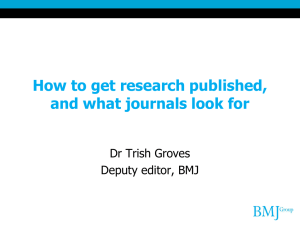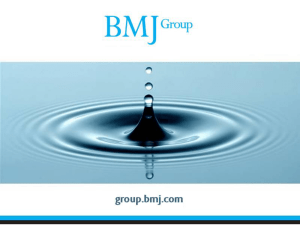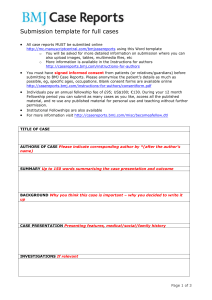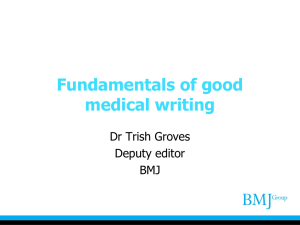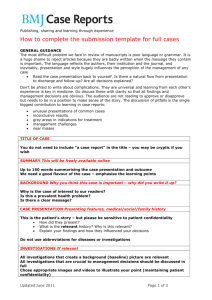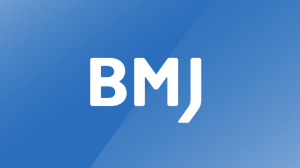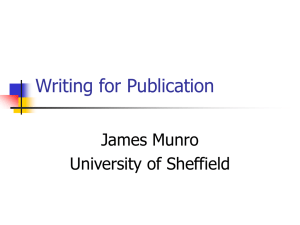The “real shit” on writing for medical and public health journals
advertisement
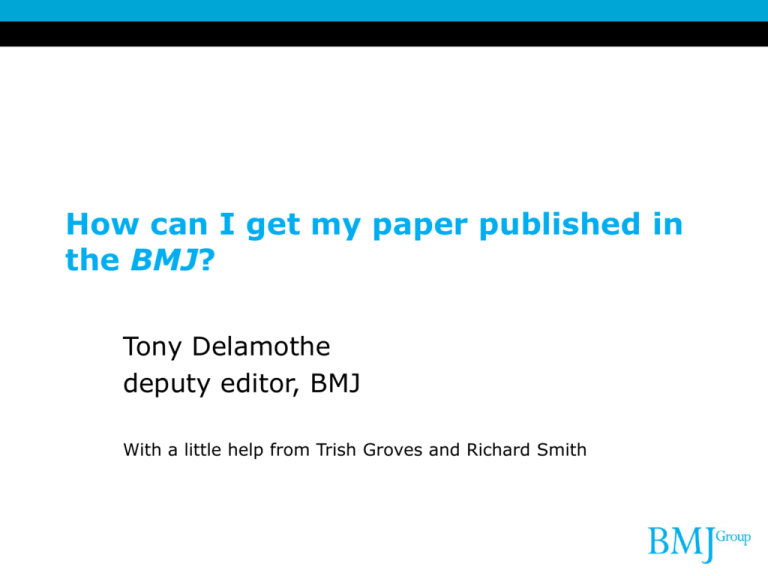
How can I get my paper published in the BMJ? Tony Delamothe deputy editor, BMJ With a little help from Trish Groves and Richard Smith What I want to talk about • • • • • Knowing me, knowing you Why do you want to publish? What do journals want to publish? What is the publication process? How is publishing changing? What’s the BMJ? • In print since 1840 • Online since 1995; full text since 1998 • Research articles remain Open Access. Recent changes • Direction: “to help doctors make better decisions” • Look and feel of print journal: more magazine-like • New online model: publishing oblivious to print. General medical journals • • • • • • Annals of Internal Medicine BMJ JAMA Lancet New England Journal of Medicine PLoS Medicine Why do you want to publish? • Answers please on a flip chart Why publish? • Because you have something important to say • To change practice • To promote thought or debate • To allow examination of your work • • To get your work in a high impact factor journal (aka “Fame and the love of beautiful women” or men) • To make money • To advance your career/keep your job • To entertain/divert/amuse • To educate What do medical journals want to publish? medical journal Remember journalistic values • • • • new true important of interest to our readers Medical journals want to publish material that is: • • • • new true important of interest to our readers Our commonest reasons for rejection are: • • • • Too Too Too Too well known specialist inconsequential far removed from patient care or public policy The brutal reality • A mismatch between what you as authors/researchers want and what we as medical journal editors want (and guess who gets to decide?) • In journalism readers take precedence over authors Published and be damned? • “Why is medicine so obsessed with those who can convince others to read what they have written? Other professions- dentists, lawyers, accountants - are judged on what they can do, rather than how many papers they have published… • “Ultimately our love of publications comes from the misguided belief that being scientists and researchers is a critical part of the practice of medicine. While this may indeed have been true during the past – Paul Langerhans discovered the pancreatic islets while at medical school – the professionalisation of medical research means that such discoveries are unlikely to be replicated in the future… Writing that paper: before you begin • • • • • What do I have to say? (“The message”) Is it worth saying? What is the right format for the message? Who is the right audience for the message? Where should I publish the message? Select journal on basis of its audience, not its impact factor or “reputation” Writing that paper: before you begin • Who is the right audience for the message? • Where should I publish the message? Select journal on basis of its audience, not its impact factor or “reputation” What do I do next? Find out what the journal wants from its: Instructions to authors Advice to contributors Resources for authors Not just research articles.. • • • • Editorials Letters Analysis articles Educational articles (from Clinical review to case reports) • Personal views, reviews BMJ - general guidance to follow • Guidelines for reporting research, at the EQUATOR network resource centre http://www.equator-network.org/ • International Committee of Medical Journal Editors uniform requirements for manuscripts submitted to biomedical journals http://www.icmje.org/ • The code on good publication practice produced by the Committee on Publication Ethics www.publicationethics.org.uk/guidelines/ COPE guidelines on good publication practice cover • • • • • • • • • • • Study design and ethical approval Data analysis Authorship Conflicts of interest Peer review Redundant publication Plagiarism Duties of editors Media relations Advertising Dealing with misconduct, including sanctions Ethics: not an optional extra Think about the wider ethical aspects of your research, even if the study was approved by an ethics committee: • might the paper allow patients’ identities to be revealed? • does the paper say enough about the information participants were given before consenting? • how much does this deviate from current normal (accepted, local) clinical practice? • what was the full burden imposed on participants? • what total risks were participants or others exposed to? • what benefit might accrue to participants or others? • what are the potential benefits to society and future patients? • Do you have an ethical obligation to report research on humans? Good reporting is part of good scientific practice • Manuscripts should present sufficient data for readers to: – Reproduce the study – Fully evaluate the information and reach their own conclusions about the results • So the key sections are: Methods and Results • Misrepresentation of studies and misleading information abound Writing that paper Structure is all. Make sure that readers know where they are, where they are going, and why. Writing that paper: IMRaD • Introduction—Why did I do it? • Methods--What did I do? • Results--What did I find? and • Discussion-- what might it mean? Writing that paper: Introduction • • • • Why did we start? Tell “the story so far” Why was this study needed? Be sure that readers understand the importance of the study-but don’t overdo it • Don’t try to show readers that you have read everything • Short, short, short Writing that paper: Methods • Should be given in enough detail to allow another researcher to repeat the study • like a recipe • describe inclusion and exclusion criteria • describe outcome measures • describe intervention • give references for standard methods • explain ethics issues • follow reporting guidelines as explained at (http://www.equator-network.org/ Writing that paper: Results • • • • • • • • Stick to what is relevant Be sure to include basic descriptive data The text should tell the story The tables give the evidence The figures illustrate the highlights Use confidence intervals rather than p values Think about absolute risk, number needed to treat, etc Avoid starting discussion Essential summary statistics for results • For a clinical trial: – Absolute event rates among experimental and control groups – RRR (relative risk reduction) – NNT or NNH (number needed to treat or harm) and its 95% confidence interval (or, if the trial is of a public health intervention, number helped per 1000 or 100,000) • For a cohort study: – Absolute event rates over time (eg 10 years) among exposed and non-exposed groups – RRR (relative risk reduction) • For a case control study: – OR (odds ratio) for strength of association between exposure and outcome • For a study of a diagnostic test: – Sensitivity and specificity – PPV and NPV (positive and negative predictive values) Writing that paper: Discussion • statement of principal findings • strengths and weaknesses of the study • strengths and weaknesses in relation to other studies (especially systematic reviews), and key differences • meaning of the study: possible mechanisms and implications for clinicians or policymakers • unanswered questions and future research • go easy on the last two Topping and tailing • • • • • Title: Include design; Don’t try to be clever Abstract: Must be structured References: Keep to the essentials Covering letter: Something very crisp Authorship, acknowledgements, competing interests Pesky bits • Trial registration • Authorship and contributorship • Competing interests (publishing in journals is definitely becoming more onerous - because the realisation that the effects of journal articles can be profound) Trial registration • Include the registration number of the trial and the name of the trial registry. Please add these to the last line of your paper’s structured abstract. The BMJ’s criteria for a suitable public trial registry are: free to access, searchable, and identifies trials with a unique number; registration is free or has minimal cost; registered information is validated; registered entry includes details to identify the trial and investigator and includes the status of the trial; and the research question, methodology, intervention, funding, and sponsorship must all be disclosed. • FDAAA additions Authorship and contributorship • • • • • credit and accountability many authors on papers have done little people’s names are left off papers authors do not know the authorship criteria contributorship statement is more inclusive and accurate – says who did what Authorship Authorship credit should be based only on substantial contribution to: • conception and design, or data analysis and interpretation and • drafting the article or revising it critically for important intellectual content and • final approval of the version to be published. All these conditions must be met. Participation solely in the acquisition of funding or the collection of data does not justify authorship. All authors included on a paper must fulfil the criteria No one who fulfils the criteria should be excluded Contributorship • contributors (some of whom may not be included as authors) listed at the end of the paper, giving details of who did what in planning, conducting, and reporting the work • one or more are guarantors, who accept full responsibility for the work and/or the conduct of the study, had access to the data, and controlled the decision to publish • researchers must decide among themselves the precise nature of each contribution Who did what? Helen C Eborall, post-doctoral research fellow1, Simon J Griffin, programme leader2, A Toby Prevost, medical statistician1, Ann-Louise Kinmonth, professor of general practice1, David P French, reader in health behaviour interventions3, Stephen Sutton, professor of behavioural science1 Contributors: SS, DPF, ATP, A-LK, and SJG conceived and designed the original protocol. All authors were involved in amending the protocol. HCE coordinated the study throughout. Data entry was carried out by Wyman Dillon Ltd, Lewis Moore, and HCE. HCE cleaned the data and ran preliminary analysis with input from Tom Fanshawe. ATP analysed the data. ADDITION trial data were supplied by Lincoln Sargeant and Kate Williams. HCE wrote the first draft of the manuscript with ATP and SS. All authors contributed to subsequent and final drafts. HCE is guarantor of the paper. Conflict of interest: a definition Conflict of interest is a set of conditions in which professional judgement concerning a primary interest (such as patients’ welfare or the validity of research) tends to be unduly influenced by a secondary interest (such as financial gain). Thompson DF. Understanding financial conflicts of interest. N Engl J Med 1993; 329: 573-6. Competing interest A person has a competing interest when he or she has an attribute that is invisible to the reader or editor but which may affect his or her judgment. Why does a competing interest matter? • it may have a profound effect on authors’ judgment • there’s a perception that this can happen, whether it does or not The best policy on competing interest Always declare a conflict of interest, particularly one that would embarrass you if it came out afterwards Problems with conflict of interest • Should it be just financial or personal, academic, political, religious, anything? • People don’t declare it because a) it implies wickedness; b) they are confident that their judgment is not affected • Might we avoid these problems by changing “conflict of interest” to “relevant” or “competing” interests? Transparency and integrity • The BMJ expects authors to present their work honestly and fully BMJ transparency policy is at: http://resources.bmj.com/bmj/authors/editorial-policies/transparency-policy The rudiments of style • • • • • • • • • • Short words Short sentences Short paragraphs No jargon No abbreviations Prefer Anglo Saxon over Latin words Prefer nouns and verbs to adjectives and adverbs Cut all cliches Prefer active to passive tense Prefer the concrete to the abstract BMJ’s publication process BMJ process The average time from submission to first decision is two to three weeks and from acceptance to publication eight to 10 weeks. These times are usually shorter for original research articles. What is peer review? • As many processes as journals or grant giving bodies • No operational definition--usually implies “external review” • Benefits come from improving what is published rather than sorting the wheat from the chaff BMJ open peer review • we ask reviewers to sign their reports and declare any competing interests on any manuscripts we send them • reviewers advise the editors, who make the final decision (aided by an editorial manuscript committee meeting for some articles, including original research) BMJ peer review process I • 7000 research papers, 7% accepted • approximate numbers at each stage: – 1000 rejected by one editor within 48 hours – further 3000 rejected with second editor – within one week of submission 3000 read by senior editor; further 1500 rejected – 1500 sent to two reviewers; then 500 more rejected – approx 1000 screened by clinical epidemiology editor and more rejected BMJ peer review process II • 400-500 to weekly manuscript meeting attended by the Editor, an external editorial adviser (a specialist or primary care doctor) and a statistician.. • …and the full team of BMJ research editors, plus the BMJ clinical epidemiology editor • 350 research articles accepted, usually after revision • value added by commissioned editorials and commentaries Appeals • always willing to consider first appeals (letter first; no need to submit revised paper initially) • more success if authors respond in detail to editors’ and reviewers’ criticisms • perhaps 20% accepted on appeal • no second appeals Reasons for us to say no Triage questions: treatment papers • Is it a randomised controlled trial or a systematic review (see later)? • If it is not an RCT, is it reasonable not to have done one? • Look for an answer to the question in the paper. If you can’t find one, reject. • If it is an RCT, was it really randomised? • If it wasn’t, reject unless you can find a good reason for not randomising Triage questions: prognosis studies • Is there a cohort of patients followed followed prospectively from when they were first identified with the disease? • Are 80% of patients followed up? • If the answer to these questions is no, we probably don’t want it. Triage questions: Questionnaire survey • We probably don’t want. This is people saying what they do rather than evidence on what they do • But is it telling us something important that we probably can’t get information on in any other way? • Or might it be a peg for an educational article. • If the response rate is below 55% we almost certainly don’t want it. Triage questions: two sorts of studies we don’t want • Prevalence study • Boring • Usually not possible to generalise beyond the particular population • Cost of illness study • Boring • Value is in the exactness, which is usually of interest to only a few • Again hard to generalise And when we do publish your article... BMJ open access • every research article published in the BMJ is immediately accessible on bmj.com to everyone at no charge • the full text of all research articles is also sent, without further intervention from the author, to PubMed Central, the National Library of Medicine's full text archive, which makes it fully accessible without delay • the BMJ immediately fulfils the requirements of the US National Institutes of Health, the UK Medical Research Council, the Wellcome Trust, and other funding bodies to make publicly funded research freely available to all Thanks Tony Delamothe tdelamothe@bmj.com

